The tabloid baron will launch a West Coast version of the New York Post next year.
The tabloid baron will launch a West Coast version of the New York Post next year.

Los Angeles can expect a lot more lurid tabloid coverage in its media future, to judge by the New York Post’s track record
(Stephanie Keith / Getty Images)
It’s been a busy week for Rupert Murdoch, the extremely elder statesman of American yellow journalism. He’s currently fending off a $20 billion lawsuit from President Donald Trump, who’s seeking revenge from the Murdoch-owned Wall Street Journal after it ran a story on a nude drawing and lewd note Trump denies he drew or wrote for the man he currently also denies was his close personal friend, Jeffrey Epstein.
Trump also has an older score to settle with Murdoch’s Fox News for its early (and accurate) election-night call that Arizona had gone for Biden in 2016. The 94-year-old Murdoch claims his fragile health prevents him from being deposed for Trump’s suit against the Journal anytime soon. Anxious to ensure that the suit goes forward, Trump announced that he had come to an agreement with the frail tabloid titan that he must be apprised of Murdoch’s health every three days—in order to make sure, one assumes, that Murdoch isn’t getting away with anything.
While Murdoch may be in delicate health, one of his media properties, the New York Post Media Group, made a surprise announcement this week that it’s expanding into Los Angeles. Murdoch is no stranger to LA. He owned 20th Century Fox for decades until Disney gave him $71.3 billion for the company in 2019. That deal greatly expanded Disney’s intellectual-property archive, but it left the film world with one fewer major studio making theatrical movies and flouting the industry’s now-dominant model of reviving legacy franchises ad infinitum.
Current Issue

Murdoch’s new foray into LA media will be called the California Post and is projected to start rolling off the presses next year. What’s surprising is not that Murdoch still wants more of the media world—it’s that in 2025, he’s making a bold move into newspapers. Where every other media guru talks digital and streaming, of AI and YouTube channels and podcast empires, Murdoch chose to return to his 1950s roots in Adelaide, Australia. Back then, he had a particular genius for sensing weak newspapers in untapped, vital markets. And true to form, Murdoch and his top print team at the New York Post sensed a media market so underserved, and a competitor so weak, it must have reminded Murdoch of an ailing Aussie backwater recycler—Patrick Soon-Shiong’s Los Angeles Times.
“Los Angeles is fast becoming a news desert,” the Post’s PR flacks announced on Monday. “Thousands of stories are going untold and countless perspectives aren’t being represented by a media ecosystem that has lost touch with the people—especially as the city and state face unprecedented challenges and leadership vacuums.”
They’re not wrong. While the paper will be based in LA, Murdoch plans to cover the whole state with the California Post, from the Mexican border to Hollywood to Silicon Valley, Governor Gavin Newsom’s probable presidential run, and the Bay Area. And Murdoch will offer Los Angeles something it has not had in a long time—a tabloid paper. Los Angeles is the second-biggest media market in the country, with a population of 13 million. And yet the Times, the city’s iconic legacy newspaper, currently struggles with a print circulation of less than 70,000 and just over 200,000 online subscribers. The Times’ closest rival is the LA Daily News, with a print circulation of around 56,000.
After Soon-Shiong bought the Times, he moved it out of its iconic downtown headquarters in 2018 to El Segundo. He then shut down its printing plant in 2024. At the start of this year, the paper laid off 115 editorial employees—more than 20 percent of its newsroom. This July on Jon Stewart’s podcast, Soon-Shiong announced that the Times will soon go public, under a plan similar to the municipal ownership scheme that’s kept the Green Bay Packers in the possession of its fan base. It’s not clear just how many remaining fans the LA Times can claim, but it’s likely well short of what it would take to reverse the paper’s tailspin.
The LA Times blames its woes on this winter’s fires for decimating important print subscriber markets in the Palisades and Altadena, but that doesn’t account for the layoffs or the reported $30–50 million the paper loses annually. The current nosedive goes back to Soon-Shiong’s decision to kill the Times’ 2024 presidential endorsement for Vice President Kamala Harris. In her home state, and in a city targeted by Trump as a blue woke stronghold, Soon-Shiong’s decision looked purely craven. The Times endured the same brutal market reversals that Jeff Bezos’s Washington Post faced after the Amazon baron’s order to spike that paper’s Harris endorsement, suffering a steep drop in subscriptions and an equally devastating loss of credibility among its readership.
When Soon-Shiong bought the Times, he wrote in an e-mail to his new staff, “As someone who grew up in apartheid South Africa, I understand the role that journalism needs to play in a free society.” As with Bezos—who was initially hailed as a brave voice against creeping MAGA authoritarianism in Washington—Soon-Shiong rapidly shed his pet image of himself as a





